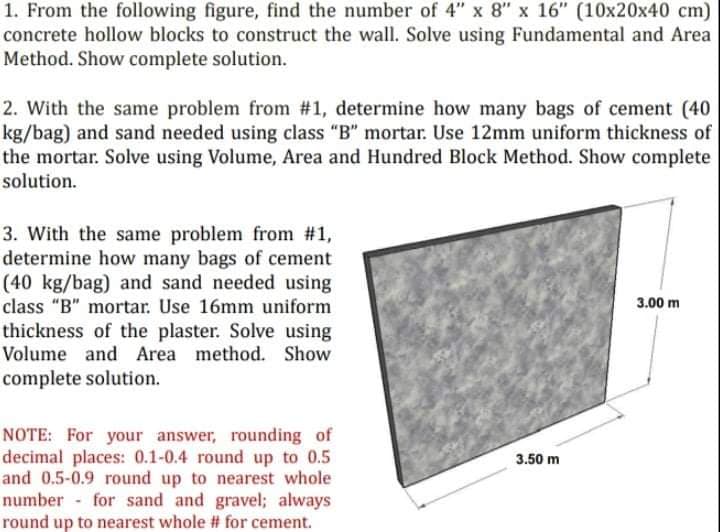1. From the following figure, find the number of 4" x 8" x 16" (10x20x40 cm) concrete hollow blocks to construct the wall. Solve using Fundamental and Area Method. Show complete solution.
1. From the following figure, find the number of 4" x 8" x 16" (10x20x40 cm) concrete hollow blocks to construct the wall. Solve using Fundamental and Area Method. Show complete solution.
Chapter2: Loads On Structures
Section: Chapter Questions
Problem 1P
Related questions
Question
Solve number 1 only ,Please show how to solve using Fundamental and Area method

Transcribed Image Text:1. From the following figure, find the number of 4" x 8" x 16" (10x20x40 cm)
concrete hollow blocks to construct the wall. Solve using Fundamental and Area
Method. Show complete solution.
2. With the same problem from #1, determine how many bags of cement (40
kg/bag) and sand needed using class "B" mortar. Use 12mm uniform thickness of
the mortar. Solve using Volume, Area and Hundred Block Method. Show complete
solution.
3. With the same problem from #1,
determine how many bags of cement
(40 kg/bag) and sand needed using
class "B" mortar. Use 16mm uniform
thickness of the plaster. Solve using
3.00 m
Volume and Area method. Show
complete solution.
NOTE: For your answer, rounding of
decimal places: 0.1-0.4 round up to 0.5
and 0.5-0.9 round up to nearest whole
number - for sand and gravel; always
round up to nearest whole # for cement.
3.50 m
Expert Solution
This question has been solved!
Explore an expertly crafted, step-by-step solution for a thorough understanding of key concepts.
Step by step
Solved in 3 steps

Knowledge Booster
Learn more about
Need a deep-dive on the concept behind this application? Look no further. Learn more about this topic, civil-engineering and related others by exploring similar questions and additional content below.Recommended textbooks for you


Structural Analysis (10th Edition)
Civil Engineering
ISBN:
9780134610672
Author:
Russell C. Hibbeler
Publisher:
PEARSON

Principles of Foundation Engineering (MindTap Cou…
Civil Engineering
ISBN:
9781337705028
Author:
Braja M. Das, Nagaratnam Sivakugan
Publisher:
Cengage Learning


Structural Analysis (10th Edition)
Civil Engineering
ISBN:
9780134610672
Author:
Russell C. Hibbeler
Publisher:
PEARSON

Principles of Foundation Engineering (MindTap Cou…
Civil Engineering
ISBN:
9781337705028
Author:
Braja M. Das, Nagaratnam Sivakugan
Publisher:
Cengage Learning

Fundamentals of Structural Analysis
Civil Engineering
ISBN:
9780073398006
Author:
Kenneth M. Leet Emeritus, Chia-Ming Uang, Joel Lanning
Publisher:
McGraw-Hill Education


Traffic and Highway Engineering
Civil Engineering
ISBN:
9781305156241
Author:
Garber, Nicholas J.
Publisher:
Cengage Learning